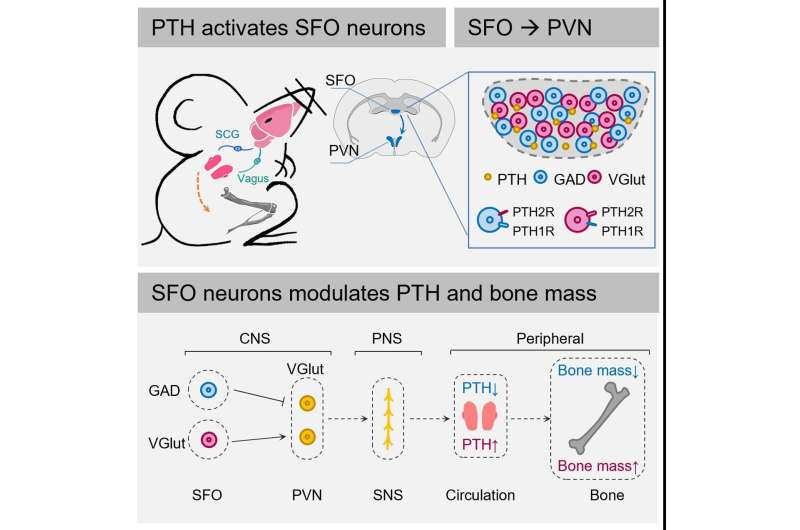This article has been reviewed according to Science X's editorial process and policies. Editors have highlighted the following attributes while ensuring the content's credibility:
fact-checked
peer-reviewed publication
trusted source
proofread
Study finds parathyroid hormone mediates interaction between brain and bones

Bones are not stagnant structures. According to recent studies, bones maintain a lively metabolism and closely interact via nerves with the brain. But whether endocrine hormones also play an important role in brain-bone talk has been unclear.
Researchers from the Shenzhen Institute of Advanced Technology (SIAT) of the Chinese Academy of Sciences now have an answer to this question. They have revealed that the subfornical organ (SFO), a brain nucleus above the third ventricle of the brain, senses circulating parathyroid hormone (PTH) and subsequently modulates the peripheral PTH level. PTH, as a powerful regulator of calcium and phosphate balance, may then alter bone metabolism and remodeling. The study was published in Neuron on April 20.
Using a mouse model, the researchers found that PTH from the peripheral system bound to SFO, a circumventricular organ without a blood-brain barrier. Brain slice electrophysiology studies and calcium fluorescent studies indicated that peripheral PTH activated the SFO neurons.
The researchers identified the expression of PTH receptors on SFO neurons. Knockdown of PTH receptor 1 induced a decrease in basic PTH levels in mice and their response to peripheral stimulation of calcium.
"These results indicate that the central nervous system (CNS) senses the circulating PTH, and the sensing of PTH from the brain is also necessary during the regulation of serum PTH," said Prof. Yang Fan from SIAT, corresponding author of the study.
Furthermore, the researchers studied whether stimulation of the SFO neurons could modulate the peripheral PTH level in return. Both GABAergic and glutamatergic neurons were activated through chemogenetic technology. Stimulation of the inhibitory GABAergic neurons induced a decrease in serum PTH and a decrease in trabecular bone density, while stimulation of the excitatory glutamatergic neurons showed the opposite effect.
"What is worth noting is, GABAergic neurons dominate the SFO cells expressing PTH receptor 1 while the glutamatergic neurons dominate the cells expressing PTH receptor 2," said Prof. Yang.
The research team also studied the brain nucleus downstream of SFO. They found that the paraventricular nucleus (PVN) of the hypothalamus that receives GABAergic projection from SFO also modulates the serum PTH level and trabecular bone metabolism.
Previous studies generally focused on the afferent and efferent nerve fibers surrounding bones when discussing brain-bone connections. Now the researchers have revealed that chemical signaling through the endocrine system also plays an important role in brain-bone talk.
"Traditionally, the subfornical organ is taken as a center of water-salt balance. Our study indicates that SFO is far more than that. The loose blood-brain barrier structure in SFO endows it with a variety of abilities sensing the peripheral humoral hormones," said Dr. Zhang Lu, first author of the study. "We expect other circumventricular organs should also perform more in the interoception process."
This study reveals the critical role of the brain-parathyroid-bone axis in maintaining bone metabolism homeostasis. It also provides new ideas for understanding how bone homeostasis is maintained.
More information: Fan Yang et al., Bidirectional Control of Parathyroid Hormone and Bone Mass by Subfornical Organ, Neuron (2023). DOI: 10.1016/j.neuron.2023.03.030. www.cell.com/neuron/fulltext/S0896-6273(23)00226-X



















